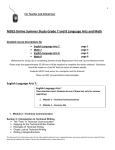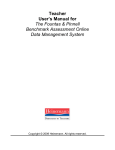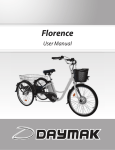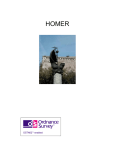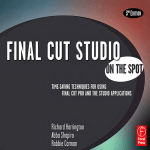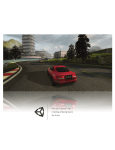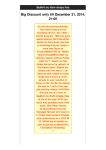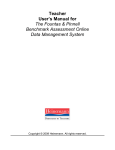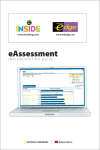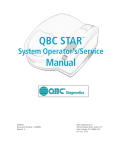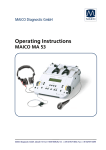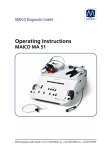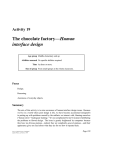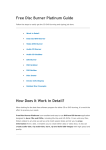Download Babe Ruth - Houghton Mifflin Harcourt
Transcript
LESSON 5 TEACHER’S GUIDE Babe Ruth by Robert Roemer Fountas-Pinnell Level Q Biography Selection Summary As a child, Babe Ruth played baseball at a home for boys in Baltimore. He began his pro career as a pitcher, and then became an outfielder. Traded from the Boston Red Sox to the New York Yankees in 1920, he went on to set home-run records. Baseball’s first superstar, Ruth enjoyed his young fans, and never forgot how lucky he was. Number of Words: 1,177 Characteristics of the Text Genre Text Structure Content Themes and Ideas Language and Literary Features Sentence Complexity Vocabulary Words Illustrations Book and Print Features • Biography • Six spreads, each with a section heading, and one summarizing heading on last page • Introductory event followed by shift back in time • Main achievements of baseball star Babe Ruth • Game of baseball • Babe Ruth changed the game of baseball. • Baseball players can be heroes on and off the field. • Conversational tone • Idiomatic language: He didn’t look like much of an athlete; How big a deal was this? • Foreshadowing: best years were yet to come • Variety in sentence length and complexity • Sentences punctuated with commas and dashes: He signed autographs, shook hands, and posed for pictures. The fans loved him for it—and this made Babe Ruth even more popular. • Baseball terms: batter, home plate, pitcher, home run, “hit one out of the park,” fastball, catcher, pro, minor league, major league, World Series, outfield, trade, homers • Many multisyllable words with varied syllable patterns, such as athlete, attention, opponents, celebrity, autographs, superstar, celebration, anniversary, dedicated • Drawings and photographs support the text. • Design motif of baseball seam • Thirteen pages with illustration on every page or spread © 2006. Fountas, I.C. & Pinnell, G.S. Teaching for Comprehending and Fluency, Heinemann, Portsmouth, N.H. Copyright © by Houghton Mifflin Harcourt Publishing Company All rights reserved. No part of this work may be reproduced or transmitted in any form or by any means, electronic or mechanical, including photocopying or recording, or by any information storage or retrieval system, without the prior written permission of the copyright owner unless such copying is expressly permitted by federal copyright law. Permission is hereby granted to individual teachers using the corresponding (discipline) Leveled Readers to photocopy student worksheets from this publication in classroom quantities for instructional use and not for resale. Requests for information on other matters regarding duplication of this work should be addressed to Houghton Mifflin Harcourt Publishing Company, Attn: Contracts, Copyrights, and Licensing, 9400 SouthPark Center Loop, Orlando, Florida 32819. Printed in the U.S.A. 978-0-547-30588-2 1 2 3 4 5 6 7 8 9 10 0940 15 14 13 12 11 10 09 If you have received these materials as examination copies free of charge, Houghton Mifflin Harcourt Publishing Company retains title to the materials and they may not be resold. Resale of examination copies is strictly prohibited. Possession of this publication in print format does not entitle users to convert this publication, or any portion of it, into electronic format. 3_305882_AL_LRTG_L05_BabeRuth.indd 1 1/6/10 4:25:38 PM Babe Ruth by Robert Roemer Build Background Have students name any baseball superstars they know of. Build interest by asking a question such as, Why do people like to read about sports superstars? Read the title and author. Discuss the cover photograph. Remind students that a true story about a person’s life is called a biography. Introduce the Text Guide students through the text, noting important ideas and helping with unfamiliar language and vocabulary so that they can read the text successfully. Here are some suggestions: Pages 2–3: Tell students that this biography tells about events from the life of George Herman Ruth, who is better known as Babe Ruth. Suggested language: Have students turn to pages 2 and 3. Point out the date in the first sentence. In paragraph 3, read the sentence: The day before, he’d hit his 59th home run of the season, tying the record he had set back in 1921. Why might the author begin the biography on this date? What might happen to Ruth’s record of home runs? Page 4: Explain that the picture shows seven-year-old George Ruth. His father is leaving him at a home for boys. George’s parents are too poor to care for him. Why is this information important to include in a biography? Page 6: Draw students attention to the section heading: George Becomes a Pro. Explain that at age 19, George Ruth was hired to pitch for a minor-league team. Because he was so young, people began calling him “Babe.” By the end of the first season, Babe had moved up to the major league and signed with the Boston Red Sox. What major league teams do you know? Page 8: Read the first sentence of paragraph 3: Babe’s performance made him a celebrity. Why did Ruth become so famous? Page 12: Draw attention to the section heading: Superstar and Legend. Explain that a legend can be an old, well-known story, and it can also name a person whose fame has spread. Read the sentence: By the time he retired, Babe Ruth had changed the game of baseball forever. What will you learn in this biography? How do you think any athlete can change the game of baseball forever? What does that mean? Now turn back to the beginning of the biography and read to find out why Babe Ruth became such a famous baseball player. Expand Your Vocabulary autographs – a person’s signature written by hand, p. 8 opponents – people who oppose each other, p. 7 record – n. a recorded top performance, p. 2 celebrity – a famous person, p. 8 performance – the doing of an action, p. 8 season – a period of the year, p. 2 inspired – gave hope to, p. 11 plate – the base where a baseball batter stands, p. 2 Grade 3 2 Lesson 5: Babe Ruth © Houghton Mifflin Harcourt Publishing Company 3_305882_AL_LRTG_L05_BabeRuth.indd 2 7/28/09 4:19:36 PM Read Have students read Babe Ruth silently while you listen to individual students read. Support their problem solving and fluency as needed. Remind students to use the Visualize Strategy mind based on details in the text. to form pictures in their Discuss and Revisit the Text Personal Response Invite students to share their personal responses to the book. Suggested language: What do you think is the most important thing to know about Babe Ruth? Ways of Thinking As you discuss the text, help students understand these points: Thinking Within the Text Thinking Beyond the Text Thinking About the Text • Babe Ruth came from a poor background, but his skill at baseball made him rich. • Babe Ruth must have had unusual qualities that other hitters didn’t have. • The author did research to find facts and also included opinions. • Babe Ruth set home-run records that were not broken for decades. • Fans love a player who makes the game exciting and who cares about them. • Babe Ruth enjoyed fans’ attention, and he became a celebrity. • Babe Ruth wanted to help children because his own childhood had been hard. • The author’s attitude is that Babe Ruth’s life story is inspiring. • The author picked events from Babe Ruth’s life to show his best qualities. © 2006. Fountas, I.C. & Pinnell, G.S. Teaching for Comprehending and Fluency, Heinemann, Portsmouth, N.H. Choices for Further Support • Fluency Invite students to choose a passage from the text to read aloud. Remind them to use punctuation to help them group words. • Comprehension Based on your observations of the students’ reading and discussion, revisit parts of the text to clarify or extend comprehension. Remind students to go back to the text to support their ideas. • Phonics/Word Work Provide practice as needed with words and word parts, using examples from the text. Use the word autographs on page 8 to point out the word parts auto (“self”) and graph (“writing”), which come from ancient Greek. Write auto, graphy, and bio, explaining that bio means “life.” Have students find the word parts in biography and autobiography, and help them to figure out what each word means. Grade 3 3 Lesson 5: Babe Ruth © Houghton Mifflin Harcourt Publishing Company 3_305882_AL_LRTG_L05_BabeRuth.indd 3 11/2/09 9:14:26 PM Writing about Reading Critical Thinking Have students complete the Critical Thinking questions on BLM 5.9. Responding Have students complete the activities at the back of the book. Use the instruction below as needed to reinforce or extend understanding of the comprehension skill. Target Comprehension Skill Cause and Effect Tell students that events can be related, with one event causing another. Thinking about causes and effects helps readers make connections among events. Model the skill, using a “Think Aloud” like the one below: Think Aloud In 1920, the Red Sox traded Babe Ruth to the New York Yankees. That event was the cause, or reason. The effect is the result. There were several effects. The Red Sox suffered a terrible loss. The Yankees got the best home-run hitter in history. Over the next fourteen years, Babe Ruth led the Yankees to six World Series titles. People made fun of the Red Sox for making the worst trade ever. Practice the Skill Have students write a sentence showing how another event in Babe Ruth’s life caused something else to happen to him. Writing Prompt: Thinking About the Text Have students write a response to the prompt on page 6. Remind them that when they think about the text, they think about the kind of writing, and about how the author used language and organized ideas. Assessment Prompts • In paragraph 2 on page 6, what is the main idea? • Which words on page 11 help the reader know the meaning of inspired? • Complete this statement: This biography was mainly written to ________________________________________________________________. Grade 3 4 Lesson 5: Babe Ruth © Houghton Mifflin Harcourt Publishing Company 3_305882_AL_LRTG_L05_BabeRuth.indd 4 11/2/09 9:14:35 PM English Language Development Reading Support Check regularly on students’ oral reading to determine accuracy, fluency, and comprehension. Idioms Explain the meaning of these idioms that include negatives, and help students use each in sentences: didn’t look like much of an athlete (page 2), couldn’t wait (page 2), never done a great job (page 12), never forgot where he came from (page 14). Oral Language Development Check student comprehension, using a dialogue that best matches your students’ English proficiency level. Speaker 1 is the teacher, Speaker 2 is the student. Beginning/Early Intermediate Intermediate Early Advanced/ Advanced Speaker 1: When did Babe Ruth live? Speaker 1: What did Babe Ruth do better than any other baseball player? Speaker 1: Why is Babe Ruth still famous today? Speaker 2: He hit more home runs. Speaker 2: Baseball fans are interested in the best players of long ago. Babe Ruth’s home-run records lasted a long time. His life story was interesting. Speaker 2: 1895 to 1948 Speaker 1: What game did he play? Speaker 2: baseball Speaker 1: What records did Babe Ruth set? Speaker 1: Why did fans love Babe Ruth? Speaker 2: He made the game exciting. He spent time with them. Speaker 2: most home runs 3_246239RTXEAN_L01-05CT.indd Page Sec4:11 3/7/09 1:17:33 AM user-043 /Volumes/118/HS00117/work%0/indd%0/Critical_Thinking/3_246239RTXEAN_U01L01-05CT Lesson 5 Name BLACKLINE MASTER 5.9 Date Critical Thinking Babe Ruth Critical Thinking Read and answer the questions. Possible responses shown: 1. Think within the text Why did Babe Ruth’s parents send him to live at St. Mary’s Industrial School for Boys? His parents were too poor to take care of him properly. 2. Think within the text How did Babe Ruth’s life change when he became a professional baseball player at age 19? He traveled on trains around the country, and stayed in different cities. He also was nicknamed “Babe” because he was such a young ball player. 3. Think beyond the text Babe Ruth was a hero to many children. They looked up to him. Who is your hero? Why do you look up to this person? Responses will vary. 4. Think about the text Why do you think Babe Ruth became so popular? He was a great baseball player, and he loved to meet with his fans. Making Connections Even though Babe Ruth was rich and famous, he still spent time visiting sick children in hospitals. In what way would you like to help others? Write your answer in your Reader’s Notebook. Read directions to students. Critical Thinking 11 Grade 3, Unit 1: Good Citizens © Houghton Mifflin Harcourt Publishing Company. All rights reserved. Grade 3 5 Lesson 5: Babe Ruth © Houghton Mifflin Harcourt Publishing Company 3_305882_AL_LRTG_L05_BabeRuth.indd 5 7/28/09 4:19:38 PM Name Date Babe Ruth Thinking About the Text Think about the questions below. Then write your answer in one or two paragraphs. The author thinks that Babe Ruth’s life story is inspiring. Do you agree or disagree with the author? Use details from the book to support your answer. Grade 3 6 Lesson 5: Babe Ruth © Houghton Mifflin Harcourt Publishing Company 3_305882_AL_LRTG_L05_BabeRuth.indd 6 7/28/09 4:19:39 PM Lesson 5 Name Date BLACKLINE MASTER 5.9 Critical Thinking Babe Ruth Critical Thinking Read and answer the questions. 1. Think within the text Why did Babe Ruth’s parents send him to live at St. Mary’s Industrial School for Boys? 2. Think within the text How did Babe Ruth’s life change when he became a professional baseball player at age 19? 3. Think beyond the text Babe Ruth was a hero to many children. They looked up to him. Who is your hero? Why do you look up to this person? 4. Think about the text Why do you think Babe Ruth became so popular? Making Connections Even though Babe Ruth was rich and famous, he still spent time visiting sick children in hospitals. In what way would you like to help others? Write your answer in your Reader’s Notebook. Grade 3 7 Lesson 5: Babe Ruth © Houghton Mifflin Harcourt Publishing Company 3_305882_AL_LRTG_L05_BabeRuth.indd 7 7/28/09 4:19:41 PM Student Lesson 5 Date BLACKLINE MASTER 5.13 Babe Ruth • LEVEL Q page 8 Babe Ruth Running Record Form Selection Text Errors Self-Corrections Accuracy Rate Total SelfCorrections In 1920, the Red Sox traded Babe Ruth to the New York Yankees for $125,000. Many people call this the worst baseball trade ever! It turned out to be a terrible loss for the Red Sox. In his first year with the Yankees, Babe hit 54 home runs to set a new record. The next year, Ruth hit 59 homers! How big a deal was this? The second place home-run hitter that year hit only 24 home runs! Babe’s performance made him a celebrity. Some celebrities hate dealing with their fans and try to avoid them. Babe Ruth didn’t. Comments: (# words read correctly/100 × 100) % Read word correctly Code ✓ cat Repeated word, sentence, or phrase ® Omission — cat cat Grade 3 Behavior Error 0 0 Substitution Code cut cat 1 Self-corrects cut sc cat 0 Insertion the 1 cat Error 1413990 Behavior ˆ Word told 1 8 T cat 1 Lesson 5: Babe Ruth © Houghton Mifflin Harcourt Publishing Company 3_305882_AL_LRTG_L05_BabeRuth.indd 8 7/28/09 4:19:41 PM








